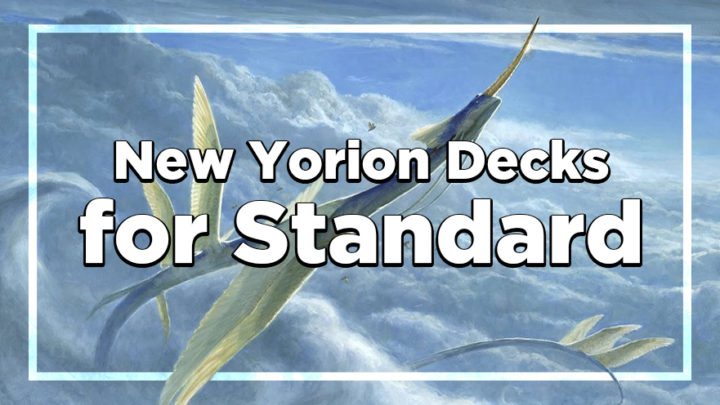This new Standard format has been moving fast. In the past week, we’ve seen the rise of Black-Green Adventures, Black-Red Kroxa, and Mono-Green Stompy. But a new menace is coming to take over Standard: Yorion, Sky Nomad.
Yorion has emerged as the best way to go over the top of other decks in the format, and there are a variety of decks you can build with it. All these decks focus on playing high-value cards with “enter the battlefield” effects to grind out value from the opponent. Typically, these decks play heavily to the battlefield and can play a fair game plan without Yorion, but with Yorion, their decks become super-charged. A card like Charming Prince is a fine early play that can do a good Yorion impression, but when you play Yorion with Prince in play, the resulting loop will overwhelm your opponent if they can’t break it up.
Here are five Yorion decks you’ll likely see on the Arena Standard ladder this week. Keep in mind that there are variations within these archetypes, too, including 80-card decks with Yorion as a companion and more traditional 60-card versions.
Esper Dance
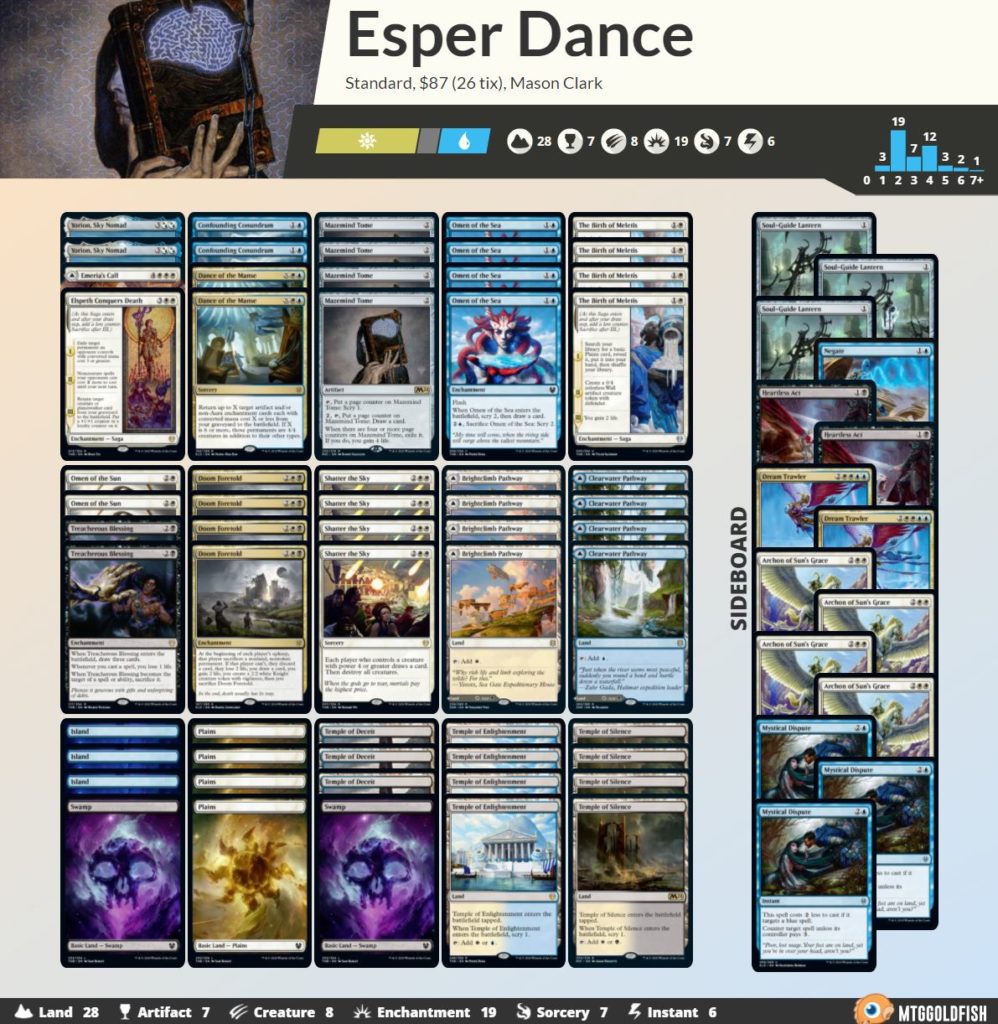
Buy this deck from Card Kingdom
Export this deck to Arena via MTGGoldfish
I talked about Esper Dance a good bit in last week’s article, and the deck hasn’t changed much since, so I’ll keep this brief.
Esper Dance was the first of the Yorion decks to pop up. Its goal is to grind opponents out of all resources, then stumble across the finish line. This build revolves around high-value enchantments like Elspeth Conquers Death and Omen of the Sea, which you can sacrifice to Doom Foretold or blink with Yorion.
However, these two game plans — blink permanents with Yorion or sacrifice them to Doom Foretold — are sometimes at odds with one another. While it isn’t a deal breaker, this sort of tension may not be worth the payoff, especially in the current metagame.
If the format moves to a place where having one or two impactful permanents on the battlefield is important, you should shift back to this deck. For the moment, decks are flooding the board, and the Doom Foretold/Dance of the Manse plan is just not up to par.
UW Yorion
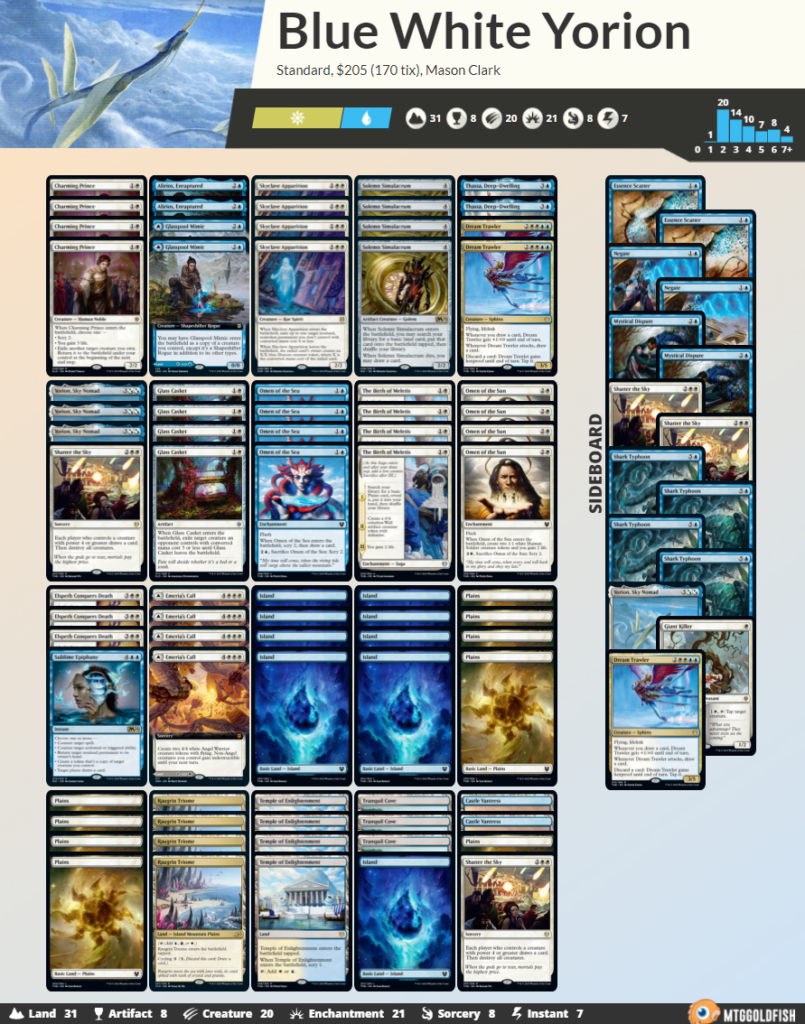
Buy this deck from Card Kingdom
Export this deck to Arena via MTGGoldfish
UW Yorion was the first creature-based Yorion deck to emerge. Unlike Esper Dance, it plays more to the board with cards like Barrin, Tolarian Archmage, Alirios, Enraptured, and Skyclave Apparition. You can also use cards like Thassa to blink these creatures or Yorion to drown your opponent in value.
UW Yorion also tries to be one of the grindiest decks in Standard. Thassa can drag out games and eventually force a win thanks to her ability to tap down blockers. The deck also doesn’t play much hard interaction — Glass Casket, Skyclave Apparition, and Elspeth Conquers Death provide some answers, but you’re also looking to simply set your opponent back with Barrin and focus on winning the long game.
One downside of this deck is that a lot of the spells are mana-intensive, which can lead to some clunky draws. That said, Dream Trawler is a big get and a powerful mirror-breaker. If it goes unchecked, Dream Trawler will help shore up some of the more aggressive match-ups, if you can survive long enough.
GW Yorion
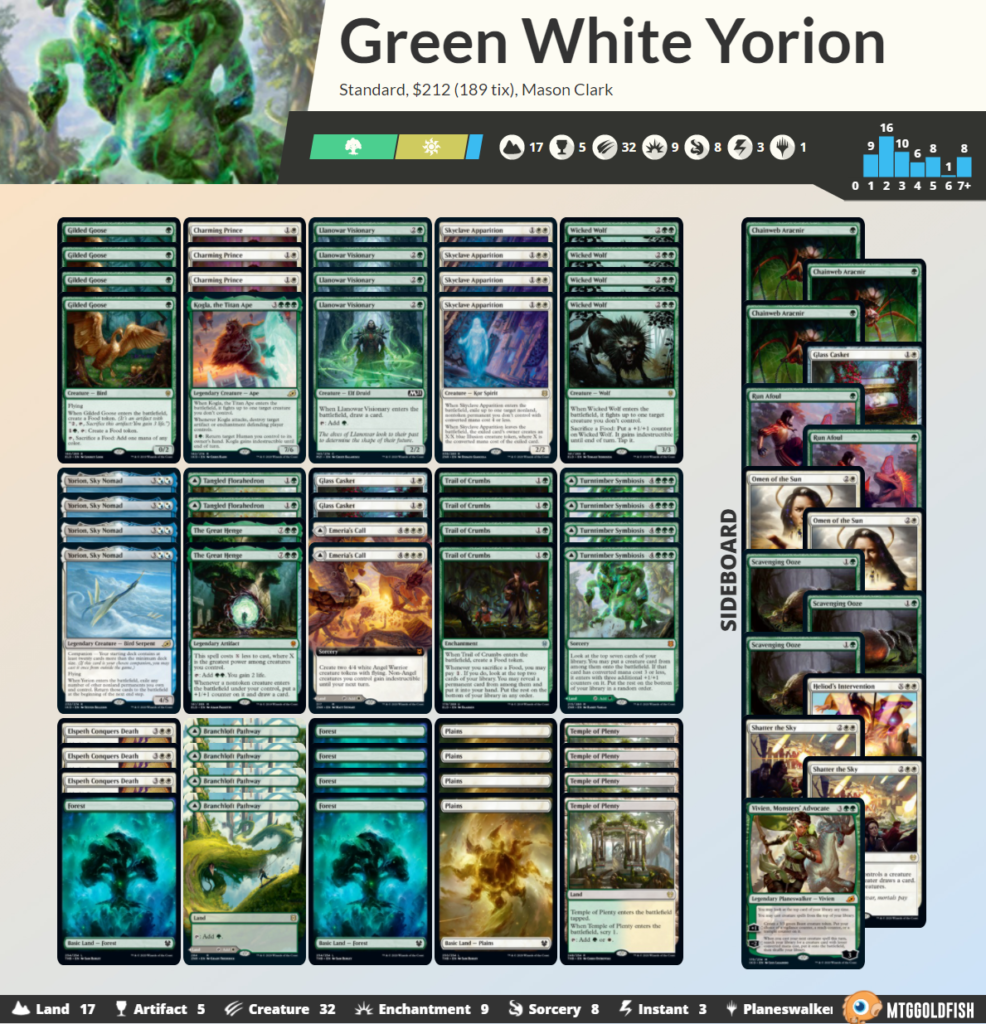
Buy this deck from Card Kingdom
Export this deck to Arena via MTGGoldfish
GW Yorion is a deck that was popularized by Bryan Gottlieb and Ondrej Strasky. Unlike the blue-based Yorion builds, it leans into food synergies, using Gilded Goose and Trail of Crumbs to accelerate your draws and Wicked Wolf to manage your opponent’s board. You also play Llanowar Visionary to help smooth out draws and accelerate toward your Yorion turns (or just cast multiple spells in a turn). All those cards are great to flicker with Yorion and allow you to play a much more proactive midrange game.
While the UW Yorion deck might be favored against other Yorion decks, this one attempts to combat the other decks in the format. It’s less focused on generating value through blink synergies and more concerned with having answers. But that’s not to say it isn’t synergy-driven — blinking Wicked Wolf, Skyclave Apparition, and even Gilded Goose will provide good value.
The GW Yorion decks are still in a formative phase, and we’ll need more time to figure out how best to build them. I’ve gone the route of trimming a bit for the aggressive decks by cutting the Omen of the Sun from the main and bringing more haymakers in the form of Elspeth Conquers Death and Charming Prince. This has become one of my favorite decks to play in Standard, and I look forward to refining it.
Bant Yorion
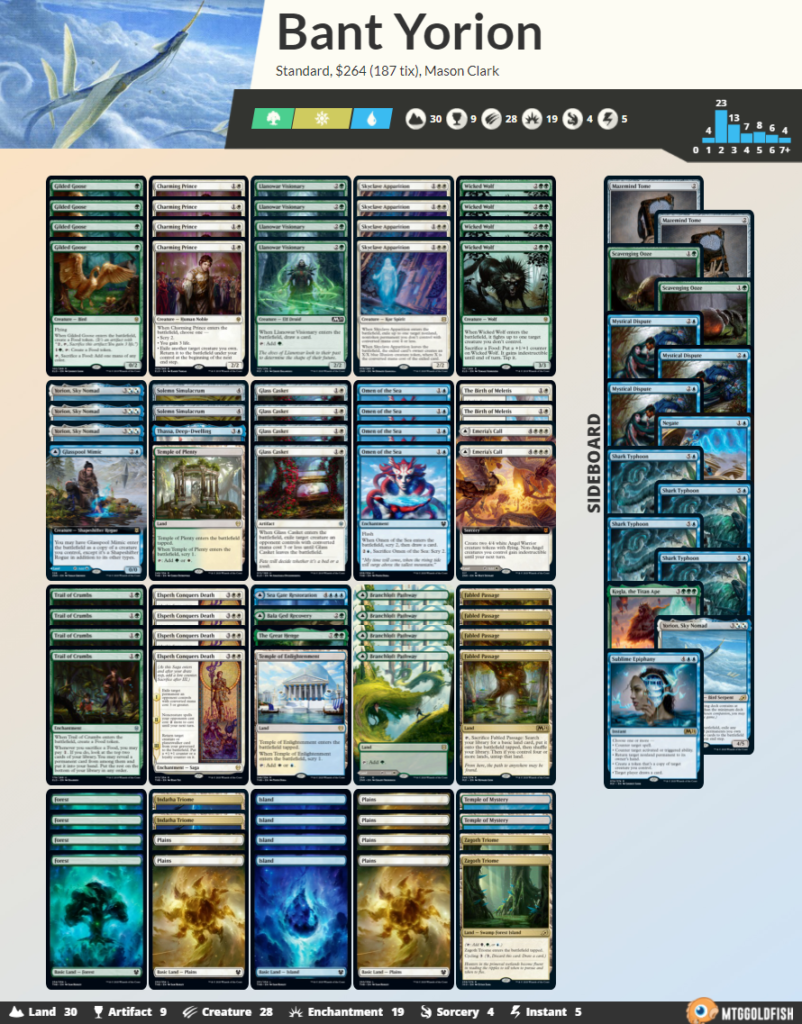
Buy this deck from Card Kingdom
Export this deck to Arena via MTGGoldfish
The Bant builds of the deck try to bring in the overwhelming late game that Thassa brings to the deck, while having Omen of the Sea to try and help smooth the draws out, that the green-white deck can have trouble with. They also play various counterspells in the sideboard, which creates some tension in the deck; should you opt for a more proactive or reactive game plan? Not anything to lose sleep over, but something you’ll need to be aware of while playing.
The biggest problem I’ve encountered with this deck is the mana. You’re playing a relatively low land count for an 80-card Yorion deck, and you’re still playing three colors, even though the blue splash is small. This archetype has a lot of promise, and while I think the blue cards can be helpful, the added strain on your mana makes this a clunkier version of GW. There’s a world where this becomes the optimal build, but currently, the risk of not being able to cast your spells is too high.
UB Control
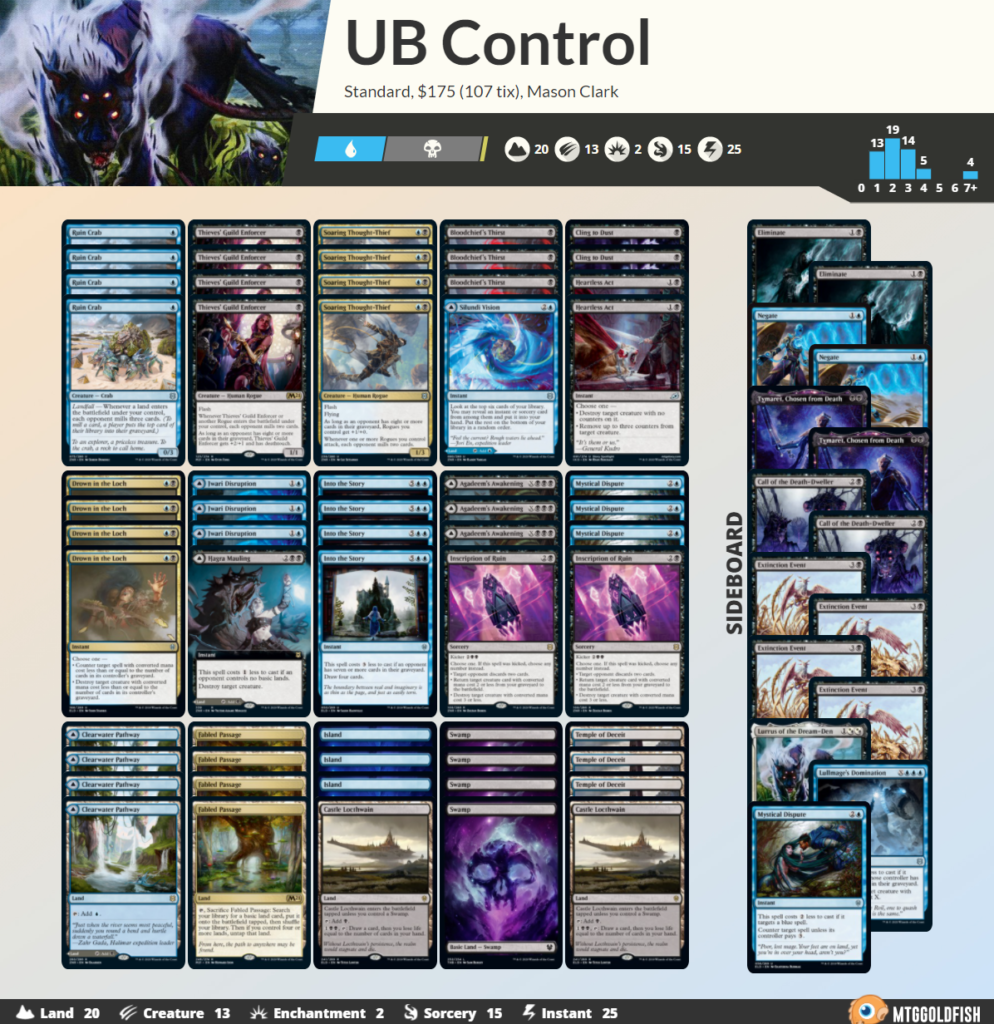
Buy this deck from Card Kingdom
Export this deck to Arena via MTGGoldfish
Let’s say you’ve read all about Yorion and you’re really not liking the idea of playing these heavy board-centric mirrors. Well, do I have the deck for you!
UB Yorion Control shares some elements with the Rogues deck I mentioned last week, but you mostly play them as spells you can get back with Lurrus to support your mill plan. While you do sometimes win by beating down with the Rogues, that’s not the primary game plan. This deck’s strength comes from enabling powerful spells like Into the Story, Drown in the Loch, and Lullmage’s Domination.
Your game plan against other Yorion decks is simply to mill them out. While some of these decks we talked about today contain 80 cards, they lack a lot of high-impact cards. As such, you should be able to break up their key pieces enough for your various mill engines to run them out of cards. This deck is very good at running the opponent out of resources, and that should be your primary game plan while playing this deck. Line up your spells effectively and you’ll see lots of success.
Conclusion
All these different Yorion decks have strengths and weaknesses, but one thing is for sure: Yorion will be a player in Standard for weeks to come. Expect to see a lot of evolution among these decks, and expect to see a lot of them on the Arena ladder. Standard is in an incredible place, and I, for one, am so happy that we can have archetypes as strong as this that are also flexible.
Have a Yorion shell you like? How about a brew that crushes Yorion decks? Tweet at @masoneclark and @card_kingdom and let us know what’s going on!

Mason Clark is a grinder in every corner of the game who has played at the pro level and on the SCG Tour with Team Nova. Whether he’s competing in Standard, Historic or Modern, Mason plays with one goal in mind: to be a better player than he was the day before. Check out his podcast, Constructed Criticism, and catch his streams on Twitch.

